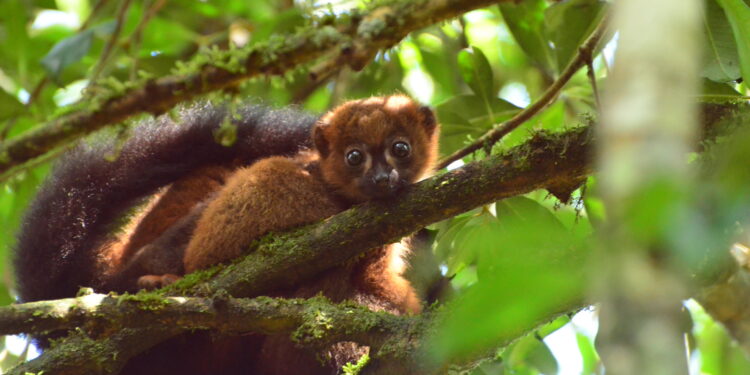Red-bellied lemur in Madagascar, one of the EDGE species identified. Credit: ZSL Rikki Gumbs
Conservation efforts targeting just 0.7% of the world’s landmass could help protect a third of the world’s unique and threatened tetrapod (four-limbed vertebrate) species, according to new research from Imperial College London, On the Edge and ZSL.
The study, conducted by researchers at Imperial College London and published this week in Nature Communicationsfinds that significant conservation gains are possible by focusing on areas with exceptional biodiversity and species with high levels of evolutionary distinctiveness and global threat.
These endangered species include animals like the aye-aye, a very distinctive lemur found in Madagascar; the long-legged, eagle-like secretary bird; the purple frog, which has a pig-like nose; and the gharial, a critically endangered, long-snouted crocodile found in the Indian subcontinent.
Currently, however, only 20% of the areas identified in the study have some form of protection, with most of them facing constant and increasing levels of human pressure.
Sebastian Pipins, lead author and PhD student at the Grantham Institute at Imperial College London, said: “Our research highlights areas of the world that are of immediate concern. It also shows that by protecting just a fraction of the planet’s land surface, huge strides can be made in preserving nature.”
On the brink of extinction
The project identified specific areas of conservation interest with extremely high levels of threatened evolutionary history, marked by their concentration of evolutionarily distinct (ED) and globally endangered (GE) species.
Evolutionary distinctiveness quantifies the uniqueness of a species, some being the result of long periods of unique evolutionary history with few or no close living relatives. Meanwhile, global threat reflects the risk of a species becoming extinct. Species that score high on both measures are called EDGE species, while areas where these species occur in high concentrations are called EDGE zones.
Pipins added: “It is crucial to consider not only species diversity in conservation efforts, but also the evolutionary history of diversity, to ensure that large and unique branches of the tree of life are not lost.”
Areas of interest
The study mapped the distribution of nearly 3,000 EDGE species, identifying 25 EDGE areas where conservation efforts can have the greatest impact.
Specific EDGE species richness areas include large parts of Southeast Asia and the Indo-Gangetic Plain, Amazon Basin and Atlantic Forest, as well as Hispaniola, the Cameroon Highlands and the Eastern Arc Mountains of East Africa.
The authors found maximum richness in an area of less than 100 square kilometers in Madagascar, which, along with Mexico and Indonesia, contains the largest number of EDGE species.
Highlighting the critical importance of national leadership to support conservation efforts, the research also found that 75.6% of EDGE species exist in a single country.
Dr Rikki Gumbs, co-author of ZSL’s EDGE of Existence programme, said: “Three-quarters of the world’s most unique animals can only live in one country, meaning action by individual nations will go a long way to protecting these incredible species from extinction.”
Very large areas of Southeast Asia have higher levels of EDGE species, which the researchers say reflects the impact of the region’s impending biodiversity disaster on the highly unique and widely distributed species found there.
Human factors
Scientists also found that the vast majority of EDGE areas face high levels of human disturbance, and that human populations in many EDGE countries face deprivations in education, health and living standards.
Dr Gumbs added: “We are currently in the midst of a biodiversity crisis, driven by unsustainable use of natural resources. It is shocking but not surprising that 80% of the areas we have identified are under severe pressure from human activity.”
Given these challenges, governments’ limited resources are often focused primarily on combating human poverty, leaving fewer resources for biodiversity conservation.
Pipins said: “Given the global importance of biodiversity in these regions, high-income countries must mobilize funds to facilitate sustainable development that can benefit both humans and nature.”
Global Goals
Only 20% of EDGE areas have some form of protection. As countries seek to protect 30% of land and sea by 2030, in line with the target of the Convention on Biological Diversity, the authors call for unprotected parts of EDGE areas to be prioritized.
Dr Gumbs said: “As the COP16 Biodiversity Conference looms, we must see world leaders around the world increase their commitments and resources to support these efforts and restore the natural world on which we all depend.”
The researchers say their findings demonstrate that significant gains in biodiversity are possible with relatively modest additions to protected areas globally. They also argue that their research offers the potential to extend the EDGE Zone approach to other important groups of wildlife, such as plants and fish.
Using EDGE Zone Search
The EDGE areas identified in this research will guide the activities of the charity On the Edge, directing its conservation grants, regional campaigns and grantee-led storytelling.
They will also participate in decision-making regarding the allocation of resources for ZSL’s EDGE of Existence programme, with a particular focus on the Gangetic Plains and Cameroon.
More information:
Sebastian Pipins et al., Promoting EDGE areas to identify spatial conservation priorities in tetrapod evolutionary history, Nature Communications (2024). DOI: 10.1038/s41467-024-51992-5
Provided by Imperial College London
Quote:Protecting just 0.7% of the world’s land could help save a third of unique and threatened species (2024, September 6) retrieved September 6, 2024 from
This document is subject to copyright. Apart from any fair dealing for the purpose of private study or research, no part may be reproduced without written permission. The content is provided for informational purposes only.



